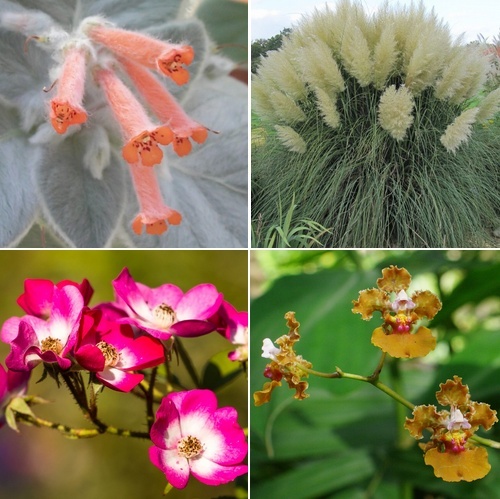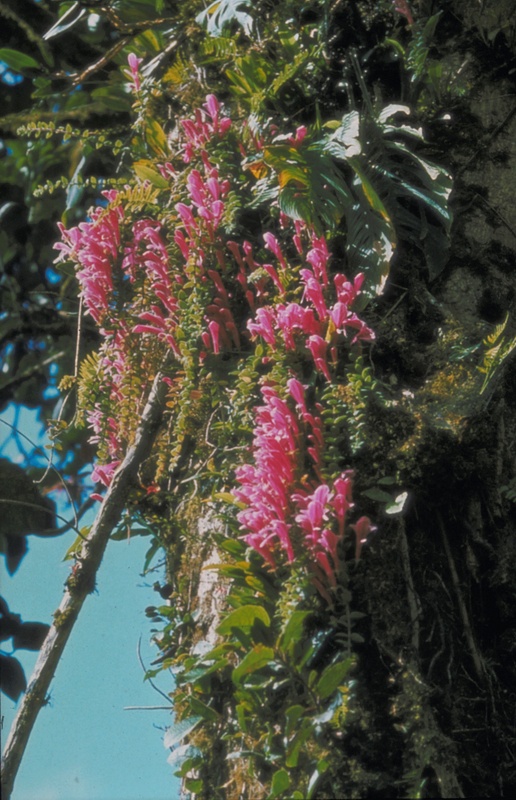
The Gesneriaceae is a plant family, just like the Orchidaceae (orchids), the Poaceae (grasses), the Rosaceae (roses, apples, strawberries, etc.) and so on. It’s a big family, with more than 3500 species and 150 genera, distributed widely and with a presence on all continents, save Antarctica. Like some other families, such as the orchids and the roses, many members have very attractive flowers and foliage, which have long attracted human attention for their beauty. We’re fortunate in that lots of the species with attractive flowers and foliage can be grown in our homes — the plants like the same conditions that we do, and bring beauty into our lives.
The majority of gesneriads are tropical or subtropical plants. These grow where there is no frost, but have wide variability in tolerance for cold, heat, humidity and drought. A few genera are adapted to alpine or temperate climates, and can live under the snow to bloom in spring.
Gesneriads are established in many places. They range from the mountains of Europe through sub-Saharan Africa; southern China through Japan and southeast Asia; the Malaysian archipelago and India; Australia, New Zealand and the Pacific Islands; and Mexico through Central America and much of South America.

The family occupies many habitats and displays many growth forms. Some very distantly related genera in Asia and the Americas have taken up an epiphytic lifestyle, growing on moss-covered tree trunks or branches and sometimes trailing flower-laden stems high above the forest floor. Others have adapted to life on rocks, where shallow mossy coverings provide an anchor for their roots and the moisture they need. Still others inhabit the dark and humid forest floor, often at stream side where sunshine sometimes strikes through a clearing. Many species are comfortable in open spaces, tolerating strong light on hillsides surrounded by rocks and sometimes cacti. In the mountains of Europe, several species grow at high altitudes, tolerating cold winters under deep snow cover.

Growth forms are just as variable. Some species are tiny, capable of growing and flowering in a thimble — while close relatives grow hundreds of times bigger, with individual flowers able to hold an entire flowering plant of the little ones. Still other genera are capable of growing into 30-metre trees. All gesneriads have fibrous roots, but some produce tubers and others scaly rhizomes. These allow the plant to die back seasonally and sprout from the roots when favourable conditions return.
Some plants are even grown for their unusual and (to some) attractive tubers, especially by fanciers of cacti and succulents. Gesneriad tubers often grow partially above ground, and can be very large.
Their beauty and ease of culture have led to the popularity of gesneriads as hobbyist plants, grown by many people around the world on their windowsills, in their greenhouses and under artificial light. The African Violet (Saintpaulia) is one of the most widely grown houseplants, bringing beauty and joy to people everywhere. Streptocarpus, sometimes known as the Cape Primrose, is well-adapted to cooler home temperatures, and is very popular in Britain and Europe. American species like Sinningia speciosa (the Florist Gloxinia), are commonly available for sale, and their spectacular beauty has developed a cult following.

Many others, less familiar, are widely grown by afficionados for their outright beauty and sometimes for their weird attractiveness.
Worldwide interest in these plants has led to the formation of many hobbyist organizations, bringing together like-minded individuals who share their enjoyment of this fascinating family. These include the Gesneriad Society (sponsor of this site); the African Violet Society of America; the British Streptocarpus Society; and many others. All have local clubs or chapters, creating the opportunity to meet and mingle with like-minded others on a regular basis.
Be warned, though. The more you find out, the more you’ll want to find out; the more plants you have, the more you will want; the more time you spend, the less you’ll have for everything else!
